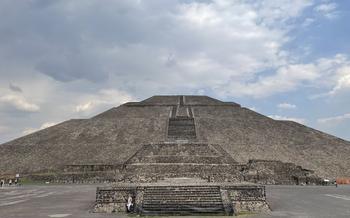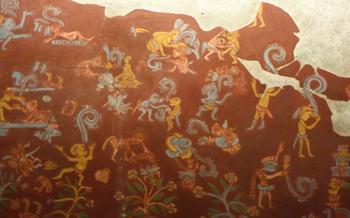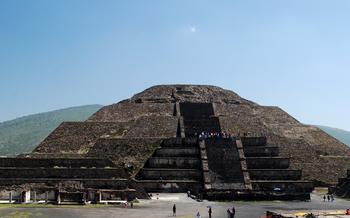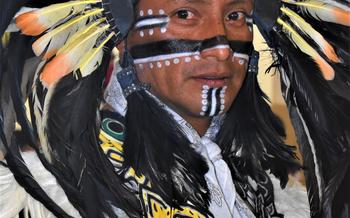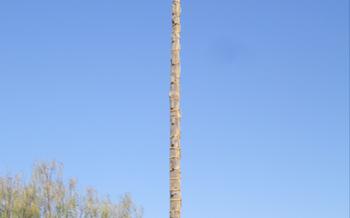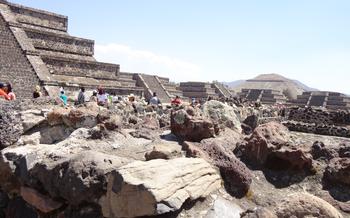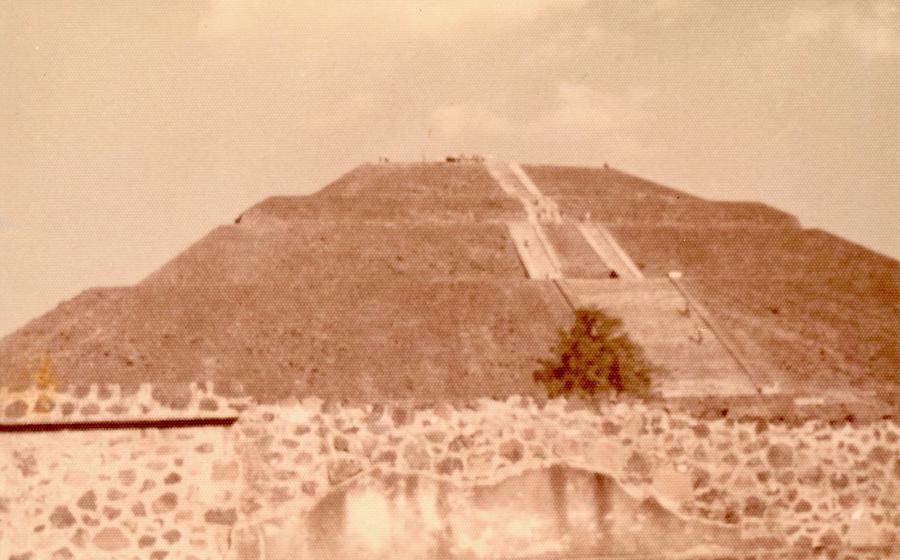
Animal Path (Sendero de los Animales)
- Teotihuacan's Animal Path: A Journey into Ancient Symbolism
- The Avenue of the Dead: A Path of Discovery
- Pyramid of the Sun: A Majestic Ascent
- Pyramid of the Moon: A Celestial Connection
- Temple of Quetzalcoatl: A Realm of Feathered Serpents
- Plaza of the Columns: A Gathering Place
- Teotihuacan's Murals: A Canvas of Ancient Stories
- Museum of Teotihuacan Culture: A Treasure Trove of Discovery
- La Ciudadela: A Fortified Complex
- Teotihuacan's Water Management System: A Legacy of Engineering
- Tips for Exploring Teotihuacan
- Suggested Itineraries: Tailoring Your Visit
- Photography Opportunities: Capturing the Essence of Teotihuacan
- Insider Tip: Unveiling Hidden Gems
Teotihuacan's Animal Path: A Journey into Ancient Symbolism
Teotihuacan's Animal Path, also known as the Sendero de los Animales, is an ancient walkway adorned with intricate carvings of various animals, inviting visitors on a journey into the depths of Mesoamerican symbolism and spirituality. This path, believed to have been constructed around the 2nd century AD, holds profound historical significance, reflecting the deep connection between the Teotihuacanos and the natural world.
As you embark on this path, you'll encounter a diverse array of animal representations, each imbued with its own unique meaning. From jaguars symbolizing strength and power to coyotes representing cunning and adaptability, these carvings provide a glimpse into the rich symbolism that permeated Teotihuacan society. Along the way, you'll also marvel at impressive structures and pyramids that flank the path, offering a testament to the architectural prowess of this ancient civilization.
Ongoing excavations at the Animal Path continue to unearth valuable insights into the lives and beliefs of the Teotihuacanos. Discoveries of ritual offerings and burials suggest that this path served as a sacred space, where people sought to connect with the divine and honor the animal spirits that held deep significance in their culture.
The Avenue of the Dead: A Path of Discovery
The Avenue of the Dead, also known as Miccaotli, served as the central artery of Teotihuacan, extending for over 2 miles (2 kilometers) from the Pyramid of the Moon to the Ciudadela. This grand avenue played a crucial role in the city's layout and was a stage for religious processions, rituals, and public gatherings.
Along the Avenue of the Dead, visitors can marvel at an array of impressive structures, including the Pyramid of the Sun, the Pyramid of the Moon, and the Temple of Quetzalcoatl. These architectural wonders showcase the advanced engineering and construction skills of the Teotihuacanos.
Archaeological excavations along the avenue have unearthed numerous artifacts, including sculptures, pottery, and offerings, providing valuable insights into the daily lives, religious practices, and rituals of the ancient Teotihuacanos. These discoveries have helped shed light on the city's complex social and political organization.
Take your time to explore the Avenue of the Dead, immersing yourself in the grandeur and history of this ancient city. Each step along this path offers a glimpse into the fascinating world of Teotihuacan and its enduring legacy.
Pyramid of the Sun: A Majestic Ascent
Ascending the Pyramid of the Sun is an awe-inspiring experience that offers breathtaking panoramic views of the Teotihuacan valley. With its imposing height of 65 meters, the pyramid presents a thrilling challenge for those seeking an unforgettable adventure. The climb involves navigating a series of steep, uneven steps, requiring a steady pace and comfortable footwear. Along the way, visitors are rewarded with stunning vistas that expand with each step, revealing the vast expanse of the ancient city and the surrounding mountains.
Reaching the summit of the pyramid is a moment of triumph, where visitors are greeted by an unparalleled view that stretches for miles in every direction. The ancient city unfolds below, with its iconic pyramids and temples arranged in a harmonious layout. The vast expanse of the valley is dotted with lush green fields, remnants of the agricultural prowess of the Teotihuacan civilization. The distant mountains add a majestic backdrop to the panoramic vista, creating a sense of awe and wonder.
Pyramid of the Moon: A Celestial Connection
The Pyramid of the Moon, the second-largest structure in Teotihuacan, holds a deep connection to celestial events, particularly the moon's cycles. Its alignment with the moon's orbit creates a mesmerizing spectacle during specific times of the year. The pyramid's orientation allows the full moon to rise precisely above its summit, casting an ethereal glow upon the ancient city. This alignment showcases the Teotihuacanos' advanced understanding of astronomy and their reverence for celestial bodies.
At the base of the Pyramid of the Moon lies the Temple of the Feathered Serpent, a sacred space dedicated to Quetzalcoatl, the revered deity associated with the wind, rain, and agriculture. Excavations around the pyramid have unearthed numerous offerings, including jade, obsidian, and ceramic vessels, providing valuable insights into ancient rituals and ceremonies performed to honor the gods and seek their blessings.
Temple of Quetzalcoatl: A Realm of Feathered Serpents
Mythological origins:
The Temple of Quetzalcoatl holds great significance in Teotihuacan's mythology. Quetzalcoatl, the feathered serpent god, played a central role in Mesoamerican beliefs, representing fertility, wind, and rain. The temple's dedication to Quetzalcoatl reflects the deep reverence and importance accorded to this deity in Teotihuacan's spiritual and cultural landscape.
Architectural design:
The Temple of Quetzalcoatl stands out for its unique architectural features. Constructed on a raised platform, the temple features a series of terraces and staircases leading to its summit. Its most striking characteristic is the presence of numerous serpent heads and feathered serpent motifs adorning its facades. These intricate carvings and sculptures bring the temple to life, creating a sense of awe and wonder among visitors.
Symbolism and iconography:
The symbolism and iconography of the Temple of Quetzalcoatl provide valuable insights into ancient beliefs and practices. The serpent heads and feathered serpent motifs represent Quetzalcoatl's protective and benevolent nature, symbolizing his role as a guardian and provider for the Teotihuacan people. The temple's alignment with celestial events, such as the summer solstice, further reinforces the sacred and cosmic significance of this structure.
Plaza of the Columns: A Gathering Place
Amidst the bustling ancient city of Teotihuacan, the Plaza of the Columns stands as a testament to the city's grandeur and significance as a central gathering place. Flanked by rows of towering columns, this vast square served as a stage for rituals, ceremonies, and communal events that brought the community together.
Its architectural elements speak volumes about the meticulous planning and engineering prowess of the Teotihuacanos. The plaza's layout features a central altar, surrounded by smaller altars and platforms, suggesting its use for various religious and ceremonial purposes. The surrounding structures, with their intricate carvings and vibrant murals, further enhance the plaza's sacred atmosphere.
Archaeological excavations within the plaza have unearthed a wealth of artifacts, shedding light on the diverse activities that took place here. From pottery fragments and obsidian tools to elaborate offerings, these discoveries provide glimpses into the daily lives and rituals of Teotihuacan's inhabitants.
As you wander through the Plaza of the Columns, imagine the vibrant energy that once filled this space. Picture the city's residents gathering for religious festivals, market days, or political events, their voices echoing through the towering columns. The plaza's enduring presence serves as a reminder of Teotihuacan's rich cultural heritage and the enduring legacy of its ancient civilization.
Teotihuacan's Murals: A Canvas of Ancient Stories
Artistic expressions: Teotihuacan's vibrant murals are a testament to the city's artistic prowess. These colorful paintings adorn the walls of temples, palaces, and other structures, showcasing a diverse range of subjects and styles. From intricate geometric patterns to realistic depictions of deities and mythical creatures, the murals offer a glimpse into the minds and beliefs of the ancient Teotihuacanos.
Symbolism and iconography: The murals of Teotihuacan are not merely decorative; they carry profound symbolic meanings that provide insights into ancient beliefs and rituals. Scholars have identified various recurring motifs and symbols, including representations of gods, animals, plants, and celestial bodies. By deciphering these symbols, researchers gain a deeper understanding of Teotihuacan's mythology, cosmology, and religious practices.
Conservation efforts: Recognizing the immense value of these artistic treasures, significant efforts are underway to preserve and restore Teotihuacan's murals. Conservationists employ specialized techniques to stabilize and protect the paintings from the elements and the passage of time. Visitors can contribute to these efforts by respecting the murals and refraining from touching or damaging them.
Museum of Teotihuacan Culture: A Treasure Trove of Discovery
Nestled in the heart of San Juan Teotihuacan, just a short distance from the archaeological site, lies the Museum of Teotihuacan Culture. This world-renowned institution serves as a guardian of the city's rich history and cultural legacy. Within its walls, visitors embark on a journey through time, immersing themselves in the captivating world of the Teotihuacanos.
The museum's extensive collection showcases a dazzling array of artifacts, each a testament to the artistry and ingenuity of this ancient civilization. Exquisite sculptures, intricately painted ceramics, and shimmering jewelry offer a glimpse into the daily lives, beliefs, and rituals of the Teotihuacan people.
Interactive exhibits and educational programs bring the past to life, allowing visitors to engage with the culture in a meaningful way. Through hands-on experiences and informative displays, the museum provides a comprehensive overview of Teotihuacan's history, from its humble beginnings to its rise as a powerful metropolis.
A visit to the Museum of Teotihuacan Culture is an essential complement to exploring the archaeological site. It offers a deeper understanding of the city's significance and the vibrant civilization that once thrived within its walls.
La Ciudadela: A Fortified Complex
Amidst the to the city's strategic prowess and architectural ingenuity. This fortified complex served as a defensive stronghold, safeguarding the city from potential threats and ensuring its security. Surrounded by formidable walls and moats, La Ciudadela exudes an aura of strength and resilience.
Within its fortified walls lies the Temple of the Plumed Shells, a sacred edifice dedicated to the veneration of the marine deity, Xipe Totec. This temple holds great significance in Teotihuacan's religious and cultural landscape, embodying the city's reverence for water and fertility. Its intricate carvings and vibrant murals depict scenes of aquatic life, symbolizing the vital role of water in sustaining and nourishing the ancient city.
Archaeological excavations at La Ciudadela have unearthed a wealth of artifacts and structural remains, providing valuable insights into Teotihuacan's military strategies and urban planning. The complex's sophisticated defensive systems, including arrow slits and watchtowers, demonstrate the city's preparedness for potential conflicts. Additionally, the discovery of residential quarters within La Ciudadela suggests that it served as a self-contained community, housing soldiers and their families who were responsible for the city's defense.
Exploring La Ciudadela is a journey into the heart of Teotihuacan's military and strategic prowess. Its fortifications, temples, and residential quarters paint a vivid picture of a city that was both secure and prosperous, a testament to the ingenuity and resilience of its ancient inhabitants.
Teotihuacan's Water Management System: A Legacy of Engineering
Teotihuacan's advanced civilization was not only renowned for its architectural marvels but also for its sophisticated water management system. The Teotihuacanos developed an intricate network of aqueducts and reservoirs to ensure a reliable water supply for their growing city.
The aqueduct system, a testament to their engineering prowess, consisted of a series of underground channels and canals that transported water from distant springs and rivers to the city. These channels were carefully designed to maintain a constant flow of water, even during dry seasons.
The Teotihuacanos also constructed impressive reservoirs to store water for domestic use and irrigation. These reservoirs, some of which were located at the base of the pyramids, were strategically positioned to capture and store rainwater.
The advanced water management system played a crucial role in supporting Teotihuacan's agricultural practices. By ensuring a reliable water supply, the Teotihuacanos were able to cultivate crops on a large scale, contributing to the city's prosperity and growth.
The legacy of Teotihuacan's water management system continues to inspire modern engineers and urban planners. The city's innovative approach to water management demonstrates the ingenuity and foresight of its ancient inhabitants, leaving a lasting impact on the development of water engineering techniques.
Tips for Exploring Teotihuacan
Exploring Teotihuacan can be a physically demanding experience, especially considering the uneven terrain and the need to climb pyramids. Therefore, it is essential to prioritize comfort and safety during your visit.
Comfortable Footwear:
Choosing the right footwear is crucial for navigating the ancient city. Avoid wearing sandals or flip-flops, as they offer insufficient support and can lead to discomfort or even injuries. Instead, opt for sturdy and comfortable shoes with good traction, such as hiking boots or sneakers.
Sun Protection:
The Mexican sun can be intense, especially during the midday hours. To protect yourself from sunburn and heatstroke, be sure to apply sunscreen liberally and frequently. Wear a wide-brimmed hat and sunglasses to shield your eyes and face from the sun's harmful rays.
Hydration:
Staying hydrated is essential, particularly in the dry climate of Teotihuacan. Bring a sufficient supply of water with you, especially if you plan on spending several hours exploring the site. Avoid sugary drinks, as they can dehydrate you more quickly.
Suggested Itineraries: Tailoring Your Visit
Whether you have one day or two to explore Teotihuacan, there are several itineraries to suit your time and interests. For those with limited time, a one-day itinerary is recommended, covering the main highlights of the site. Start your day early to beat the crowds and climb the Pyramid of the Sun for breathtaking views. Explore the Avenue of the Dead, admiring the impressive structures along the way. Visit the Temple of Quetzalcoatl to learn about the significance of this feathered serpent god. In the afternoon, explore the Museum of Teotihuacan Culture for a deeper understanding of the city's history and culture.
For those seeking a more in-depth exploration, a two-day itinerary is ideal. On the first day, follow the one-day itinerary mentioned above. On the second day, venture beyond the main attractions to discover lesser-known sites. Visit La Ciudadela, a fortified complex with impressive fortifications and the Temple of the Plumed Shells. Explore the Teotihuacan's water management system, marveling at the engineering prowess of the ancient Teotihuacanos. Take your time to wander through the residential areas and appreciate the daily life of the ancient city. With two days, you'll have the opportunity to delve deeper into the history, culture, and significance of Teotihuacan.
Photography Opportunities: Capturing the Essence of Teotihuacan
Teotihuacan offers a photographer's paradise, with its iconic pyramids, vibrant murals, and sweeping vistas. Sunrise and sunset are the most magical times to capture the essence of this ancient city. As the first rays of sunlight illuminate the pyramids, they cast long shadows that create a dramatic effect. Similarly, the golden hues of sunset bathe the ruins in a warm glow, transforming them into a photographer's dream.
To capture unique perspectives, venture off the beaten path and explore different angles. Climb to the top of the pyramids for breathtaking panoramic views, or find hidden corners and secluded spots to capture intimate details of the ruins. Experiment with different lenses and techniques to create dynamic compositions that showcase the grandeur and beauty of Teotihuacan.
Insider Tip: Unveiling Hidden Gems
To truly immerse yourself in the magic of Teotihuacan, consider arriving early in the morning before the crowds descend. This will allow you to experience the site in a tranquil and serene atmosphere, capturing the essence of its ancient grandeur.
Enhancing your exploration further, I highly recommend hiring a local guide. These knowledgeable individuals possess a wealth of insights and stories that will bring Teotihuacan's history to life. They can guide you to hidden gems often overlooked by the casual visitor, revealing the secrets and mysteries that lie beneath the surface.
With a local guide, you'll gain a deeper understanding of the symbolism, rituals, and beliefs that shaped this extraordinary city. Their expertise will transform your visit into an unforgettable journey through time, allowing you to connect with the spirit of Teotihuacan in a truly profound way.

